
The composting area is just about finished. It has 4 x 1-meter square bays and the end has a small tool
shed for storage of composting tools, etc.
The weather like just about everywhere in the UK at present is somewhat unsettled and unpredictable! But we try…..
In spite of the weather, the building works at the Gardens@Nanpean, better known as The Stables, is continuing apace! The composting area is almost complete with the guttering to place and the water butt to site at the side to augment water supply.
Paul added a little shed on the end of the compost building to allow storage for those items that are needed for composting so they are close to hand instead of having to drag them back and forwards across the gardens.
A water butt will be sited on the end and maybe another will be added later. All of the materials except for the concrete blocks were recycled from the property and from a few wooden pallets given to us by neighbors. Thank you very much….
Loraine is already producing much-needed compost from our small wormery, and now she is using the composting bays to produce much more. The first bay is already full and the second is half full and using the compost thermometer shows that the piles are certainly performing as they should be and have reached the required temperature to facilitate successful composting.
Paul has also been busy removing ivy from our trees around the property which is in danger of killing the trees it has grown on. Just a few left to clear now and this task will ensure that the trees get sufficient light to grow properly and the extra weight of the ivy would have brought down some of the limbs on the host trees. In the end, the host tree would be killed by the ivy as it overpowered it.
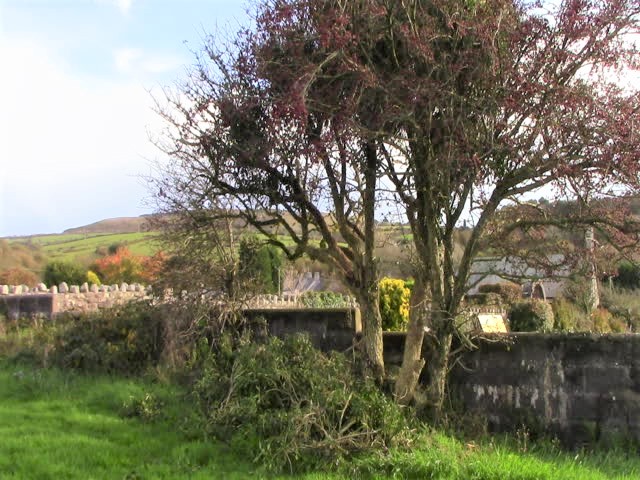
One of the trees with ivy seen in the canopy is being taken down and
removed to allow the tree to grow properly and have a full life.
Moving on, work is well underway on the garden wall that will eventually enclose the whole of the vegetable garden with a 4 – 5ft wall that will not only act as a windbreak but will also keep out smaller mammals to an extent. Made from high-density concrete blocks the wall will be strong and stable and able to withstand all the elements that affect the South-West corner of the UK here in Cornwall.
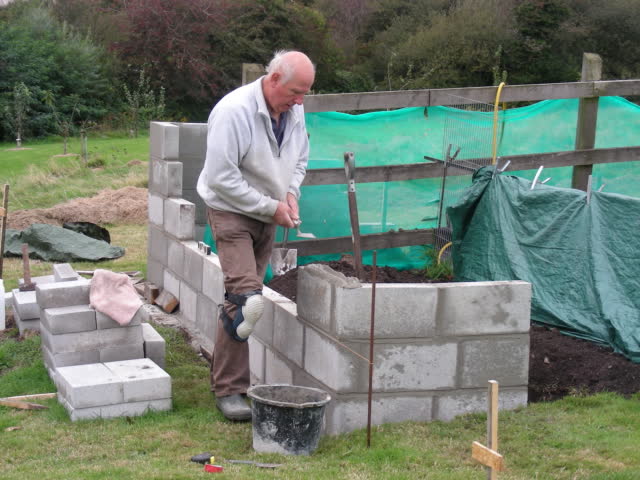
The first stage of the South-facing garden wall is to go right around the new garden area.
The first section of this new wall is built of the very uneven ground as the ground not only slopes down from the North, it also slopes down from the East. As the wall in the first section was over two blocks lower than that on the east end of this section, it had to be augmented with a raft of blocks laid to support this extra height and to negate any ground and wall movement in the future. I added returns on the wall to section the inside garden into smaller areas of beds, and to provide further support for the wall in high winds.
The return wall as seen above is where the main garden gate will go into the gardens area. In the next photo, you can see the continuing wall as it stretches out to the East of the garden. The return at the far end is where the wall will run down to the Cemetary wall and join in to complete the Southern section. The posts as you see below will support the gate which Paul has already made to fit and just needs varnishing before it can be hung.
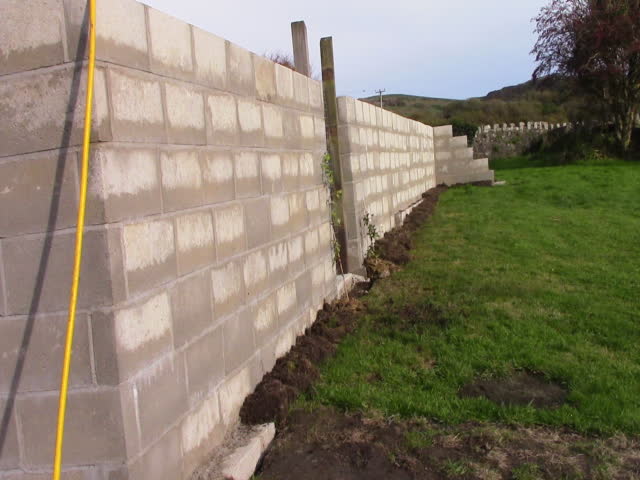
The Southern wall is nearly complete with just the return down to the cemetery
wall to do in this section.
On either side of the main gate we have already planted a Clematis to grow up the sides and a wire arch will be fitted soon enabling the clematis from either side to grow up and over this arch.
The gate will be hung to open inwards so the wind cannot catch it so easily and heavy galvanized hinges will be used along with a galvanized gate latch to enable opening and closing from either side.
We are at present discussing what to plant along this southern wall as it will be exposed but will also get the full sun all day long. We do not want huge shrubs here as we do not want to limit the light into the walled garden area, so some thought has to be given to this.
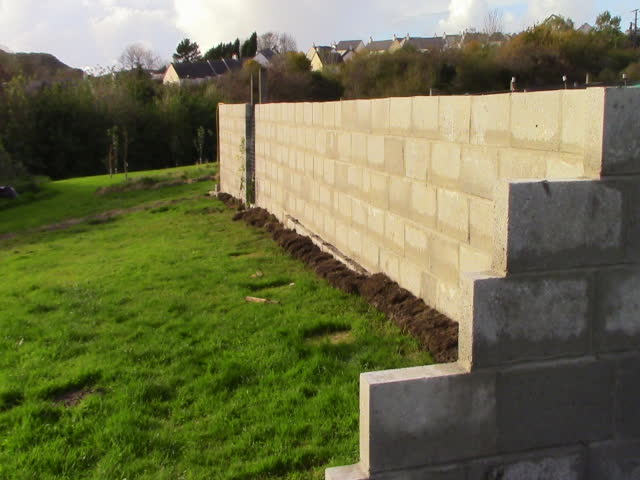
Here the wall can be seen from the East end looking towards the Orchard in the
background. The area in front of the wall will be used as a drop-off point.
As this is at the top of the ramp up to the fields, we thought we would leave a little area to use as a drop-off point when bringing up materials for further works or indeed compost bays. The next step is to start building up the West wall as the South and West walls get the brunt of the winds and bad weather so we thought it prudent to start with these walls.
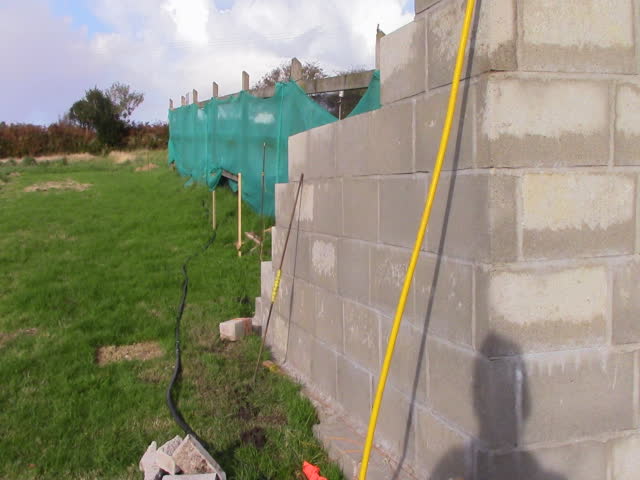
The proposed line of the West wall.
This will be the longest of the walls which will be stepped to allow for the rise of the field as it travels North. As the corner is already built it is just a matter of digging the trench to the top corner and then constructing the wall working upwards. This section will take approximately 250 blocks to construct up to the North corner.
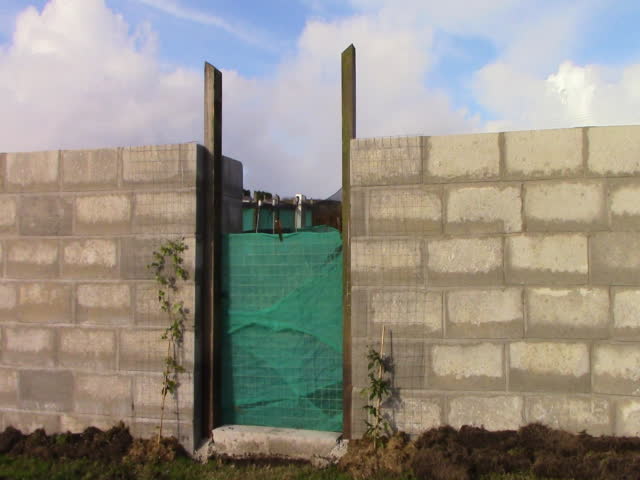
This photo shows the Main Gate of the walled garden area with its wooden posts
already in situ. You can just make out the Clematis on either side of the opening.
From the step level to the top of the wall is about 1.4 meters and the bespoke gate will come just over the height of the wall. We are hoping to get that on in the next week or so depending upon the weather mainly.
A concrete ramp on either side of the gate needs to be laid to enable a wheelbarrow to easily traverse the gate entrance without losing much of its load.
Paul still has the next 4 pallets of blocks to bring up to the field along the Westside for building this section, that’s about 288 blocks all told. He does around 25 blocks to the load in the car so that is approx 12 trips. After this is complete we can order this year’s delivery of compost (about 5 tons) which will also need to be brought up into the garden area. On rainy days we can continue in the polytunnel, digging up the layers of the sand-ring which consists of the top layer of rubber chippings and high in silica sand, then a membrane, and finally a 12-inch layer of large granite chips which all have to be removed before filling the hole with compost to enable the growth of the plants.
Anyways, more of that later and we hope you enjoyed the updates.